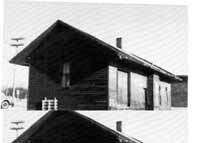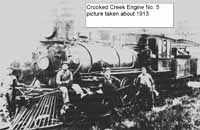Crooked Creek RR and Coal Company
By Martin E. Nass
Transcribed for the IAGenWeb Project by Janelle Martin, with permission of Martin "Ed" Nass.
Walter C. Willson, the man who built up the town of Newcastle and changed its
name to Webster City, realized that the city on the prairie was growing. The
supply of timber was not going to be sufficient to allow for heating the homes
with wood much longer. Some small coal mines were developed at Tunnel Mill and
Boneís Mill, but they did not produce the large quantities of coal that would be
needed.
Willson, who earlier had acquired large holdings of coal lands near Lehigh
along Crooked Creek, conceived the idea of building a railroad from some point
along the Illinois Central (then called the Iowa Falls and Sioux City Railroad)
line to Lehigh. Coal could be hauled much cheaper and faster than the current
method of hauling the loads by team and wagon. Willson was familiar with
railroading, having graded and constructed the line from Iowa Falls through
Webster City and on to Storm Lake in 1869. He determined that the simplest
solution would be to build a short line south from the Illinois Central tracks
to Lehigh.
To find the best route, Willson started walking north from Lehigh, noting the
need for bridging and places where cuts would have to be made. He arrived at
Border Plains, an early settlement located west of Homer. Then he continued
north to a junction with the main line between Webster City and Fort Dodge.
To raise funds, Willson went to Milwaukee, Wisconsin, and met with J. H.
Judd, George Burnham, C. D. Burnham, and John Q. Burnham. These four men agreed
to invest money in the new corporation, the Crooked Creek RR and Coal Company.
Then on December 21, 1875, he traveled to Des Moines and filed the articles of
incorporation with the Secretary of State. Capital stock was $500,000, issued in
5,000 shares with par value of $100 each. The directors signing the original
articles were W. C. Willson, Jacob M. Funk, and S. B. Rosenkrans. The railroad
was no longer Willsonís dream. He was now authorized to lay rails, sink mines,
and haul coal.
The Hamilton Freeman reported on October 4, 1876, that the first six miles of
track had been "ironed" and that the engine and rolling stock were already
there.
A later news article in the Hamilton Freeman of January 10, 1877, reported
that the original intent was to put down a wooden track, costing not over $5,000
per mile. This idea was soon abandoned, and instead a narrow gauge line of
fish-plate iron was laid over the nine-mile route. A town was laid out at each
end of the line. The junction with the main line was called Judd (for J. H.
Judd), and Lakawana was the name given to the southern terminus.
The newspaper account continues by describing Judd as having a good depot,
telegraph office, and 57 acres of land on which people were encouraged to
settle. Lakawana (now Lehigh) was reported to have only one dwelling on October
1, 1875, but by January 10th boasted 35 houses, stores, shops, a
hotel, and mills. About 100 miners had been hired to work the mines.
To transfer the coal, the Illinois Central laid a track parallel to its main
track but elevated above it. This was necessary so that the narrow-gauge coal
cars would be at the same level as the standard gauge cars. A "Wye" was
constructed that allowed the Crooked Creek train to travel north, take a curve
west, then back up parallel to the Illinois Central. Men were hired at 10 cents
per hour to shovel the coal from the Crooked Creek cars to the Illinois Central
cars. After the cars were unloaded, the train backed up until it cleared the
"Wye" and then took a curve back south to Lakawana.
At first, the tracks stopped at Chance and McClure Mines on the east side of
Lakawana. The depot was located in a large brick building south of a wagon
bridge across the Des Moines River. In 1879, a 370-foot wooden bridge spanned
the river and provided access to the Crooked Creek mines.
The entire line was now complete. Ten bridges were required. The entire cost
of construction was $59,815. The locomotive cost $12,630; a passenger car,
express car and 33 freight cars totaled another $22,310.
The Crooked Creek RR continued operation for four years, one month, and two
days. It was a real success. Willson decided that he would rather bring the coal
directly into Webster City and convert the narrow gauge line to standard gauge.
To effect this he organized the Webster City and Southwestern Railroad, which he
incorporated on October 31, 1883. The directors of this railroad were W. C.
Willson, Jacob M. Funk, and S. B. Rosencrans. It used the route from Lehigh to
Border Plains but then turned east to pass though Brushy and Flugstad and on to
Webster City, a distance of 13 Ĺ miles. A new depot and roundhouse were
constructed where the new Hy-Vee grocery store is under construction. The depot is pictured with this story.
The official name of the road was Webster City and
Southwestern RR, but the local people continued to call it the Crooked Creek RR.
On August 1, 1900, tragedy struck when Willson, President and General Manager,
was helping unload a car of slag. The car toppled over and crushed him. His
funeral had the largest attendance of any funeral in the history of Webster
City. Special trains transported miners from Lehigh and friends of Willson from
Fort Dodge. |  |
 |
After Willsonís death, Jacob Funk took over as President. When Funk died in
1903, Willsonís son, Frank E. Willson took over as Secretary and General
Manager. A 1907 letterhead lists C. E. Burnham, Pres.; F. Paul Stone, Vice
Pres.; C. L. Burnham, Sec.; L. A. McMurray, Treas; and F. E. Willson, General
Manager.
The Webster City Journal reported on December 1, 1910, that the Fort Dodge,
Des Moines and Southern, an interurban line, had purchased the Crooked Creek RR
and the Webster City and Southwestern RR for $112,000. This transferred the
right of way, the rolling stock, and the terminals to this line. |
|